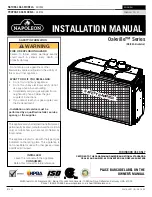
Sensor Installation
30
Modline 5
Because Series 5R Sensors measure the ratio of radiation intensities at two wavelengths rather than the
absolute intensity of radiation at a single wavelength, they are almost immune to error caused by loss
of signal. Small targets that do not fill the field of view and partial obstructions from bursts of steam,
dust and solid objects in their sight path can be tolerated.
3.5.4
Signal Reduction
Three causes contribute to the loss of signal:
Low target emissivity.
The measured object is too small to fill the reticle as seen in the Sensor sight and is not completely
resolve.
Partial obstruction of the optical path caused by smoke, steam, dust, dirty window or a solid
object.
The total reduction in signal is the sum of the losses from all three causes.
Example: Assume the target emissivity is 0.45. The reduction in signal due to low emissivity is 55%. If the
instrument can operate with a 95% signal reduction, another 40% can be lost due to an unresolved target and/or
obstructions in the cone of vision such as smoke, steam, dust, a dirty window or partial blockage by solid objects.
Figure 14: Invalid Measurement Conditions
When you reach the maximum allowed reduction, the Sensor will indicate “Invalid”. An Invalid
measurement condition also occurs, without any obstructions, if the target temperature signal is below
a level that can be accurately measured by the instrument.
Signal Reduction Tolerated
The Series 5R Sensors have a limit as to how much the signal from a hot target can be reduced. The
reduction in the signal can be as high as 95% with target temperatures above 800
C (1500
F). The
Target Emissivity = 0.45
Target
Valid Measurement Conditions
Target
Target
Invalid Measurement Conditions
Total Signal Loss Greater than 95 %
1. Intense Smoke in Sight Path
2. Target too small for Spot Size
3. Low Emissivity
Sensor
Sensor
Sensor
Cone of Vision
Smoke in Sight Path
















































